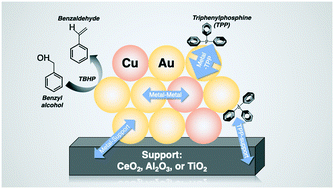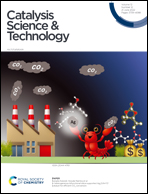Support, composition, and ligand effects in partial oxidation of benzyl alcohol using gold–copper clusters
Abstract
The application of gold bimetallic nanoparticles and clusters in oxidation catalysis has produced many advances in performance over their monometallic gold counterparts. In this work, triphenylphosphine (TPP)-bound gold–copper alloy clusters are synthesized and characterized in solution and on supports such as ceria, alumina, and titania. A comparative study on the effects of the alloy composition, support, and TPP in benzyl alcohol oxidation is presented for the first time. The activity and selectivity of the supported clusters is also compared with the same clusters when they are unsupported in solution. It is observed that the activity of TiO2-supported catalysts is the most sensitive to the Au : Cu ratio, while Al2O3 and CeO2-supported catalysts are less sensitive. Consistent with other observations in the literature, intermediate compositions of Au and Cu provide for the most active benzyl alcohol oxidation catalysts in both supported and non-supported systems. Catalysts which are able to activate oxygen at a higher rate can enable the oxidation of the TPP which may lead to more open catalytic active sites on the surface of these clusters. The results of this work illustrate the complex interplay between alloying metals, supports, and ligands in benzyl alcohol oxidation and have the potential to be applied to other Au alloy oxidation reactions.



 Please wait while we load your content...
Please wait while we load your content...